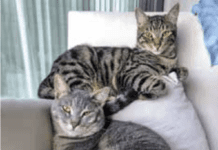Editors Note: My apologies to longtime readers of CatWatch whove read about George in previous winter issues, but to shield feline roommates of recent subscribers from his shocking problem, I decided to run it again.
———-
I have a fluffy cat named George, and in the winter his coat is dry and he is very prone to static electricity. All I have to do is touch him and I give him a shock. When he comes up to greet me when I get home at night, I pet him, give him a shock, and he looks up at me wondering why Im being so mean to him. Is there anything I can do to keep from shocking my cat?
Yours is a common problem, at least for cats and people living in parts of the country with cold winters. Heating the home during the frigid months is an absolute necessity, but therein lays the problem. Cold air cant hold nearly as much water as warm air can, so when the cold outside air is heated inside our houses, the relative humidity of the room air can become very low. Even at a relatively mild 40 degrees F outdoor temperature with 80 percent relative humidity, that same air warmed to 70 degrees F inside the house drops to a much drier 20 percent relative humidity. And its the dry air thats the culprit, not you or your cat.
Static electricity builds up when one insulating surface – like a dry hand – is rubbed against another insulating surface – like dry cat fur – and then separated. Stroking Georges fur and moving your hand away causes an imbalance of electrons between the two surfaces, and when you touch him again, especially on a more electrically conductive area like his nose or ear tips, the rapid return of a balanced electrical state results in a spark. The same thing happens as you build up a charge while walking across the carpet and then touch something more conductive, like a metal shelf. This electrostatic discharge, or ESD, can feel quite painful, with voltages ranging up to thousands of volts.
Keep the Surfaces Moist…and Dont Touch George First!
Anything that increases the electrical conductivity of surfaces decreases the electrostatic voltage, and one of the most effective ways of increasing the conductivity is to keep the surfaces more moist. Using a humidifier can help tremendously during the winter months and is probably the best way to make your relationship with George less shocking.
Walking across a synthetic carpet can generate as much as 35,000 volts in a room with 20 percent relative humidity, in contrast to only 1,500 volts when the humidity is increased to 80 percent, so it can make a big difference. (By the way, we usually cant feel ESD voltages of less than 3,500 volts.) Just make sure to keep the humidifier clean so that bacteria and molds wont be released along with the water vapor.
Keeping your hands moist with lotion can help, too, as can keeping Georges coat and skin moisturized. Your veterinarian or groomer should be able to supply you with a cat-safe conditioning rinse or spray that can help his coat retain moisture. And before you greet George after coming indoors, or after youve shuffled across the carpet to scratch him under the chin, make sure to discharge your stored voltage by touching a metal surface just before you touch him. You may still arc a spark-less painful to you if you touch the metal with a key – but at least you wont zap poor Georges nose!



